Overview
This article examines the fundamental differences between plurality and majority voting systems, underscoring their unique criteria for determining election winners.
-
Plurality voting allows a candidate to win simply by securing the highest number of votes, without the necessity of achieving a majority. This can lead to voter dissatisfaction, as the elected candidate may not reflect the preferences of the majority.
-
In contrast, majority voting guarantees that the elected candidate enjoys broad support, thereby enhancing the legitimacy of the electoral process and fostering public trust.
Understanding these distinctions is crucial for informed decision-making in electoral contexts.
Introduction
Understanding the nuances between plurality and majority voting systems is essential for any organization aiming to foster fair and effective electoral processes. Plurality voting, often termed ‘first-past-the-post,’ offers simplicity and speed; however, it can lead to outcomes that fail to reflect the broader electorate’s preferences. Conversely, majority voting requires a candidate to secure over 50% of the votes, promoting greater legitimacy and acceptance among voters.
This choice between these systems raises critical questions about representation and voter engagement: how can organizations ensure that every voice is heard while maintaining a streamlined electoral process?
This article delves into the key differences between plurality and majority voting, exploring their implications for election outcomes and voter participation.
Votem: Secure Online Voting for Plurality and Majority Elections
Votem’s CastIron platform is expertly crafted to support secure online voting for elections involving plurality versus majority, ensuring adherence to essential regulations such as NCUA and DOL. This compliance positions Votem as a trusted partner for labor unions and credit unions seeking reliable electoral solutions. Notably, organizations that have adopted eVoting report turnout increases of up to 15%, demonstrating the platform’s effectiveness in boosting engagement. The platform’s mobile-first design significantly improves accessibility, enabling citizens to engage from any location. Additionally, Votem’s commitment to WCAG 2.1 AA accessibility standards ensures that all members, including those with disabilities, can engage in the electoral process. Votem’s steadfast emphasis on not only fosters trust among the electorate but also protects the integrity of the electoral process.
As Kraig Kitchin, Union Leader, noted, “Votem successfully handled the receipt of 299,000 votes on behalf of the National Radio Hall of Fame, an increase over last year’s 126,000 votes received.” This real-world example underscores Votem’s impact and effectiveness, making it an ideal choice for organizations committed to fair and accountable elections. Furthermore, utilizing Votem’s eVoting solutions can lead to substantial cost savings, allowing resources to be allocated more efficiently.
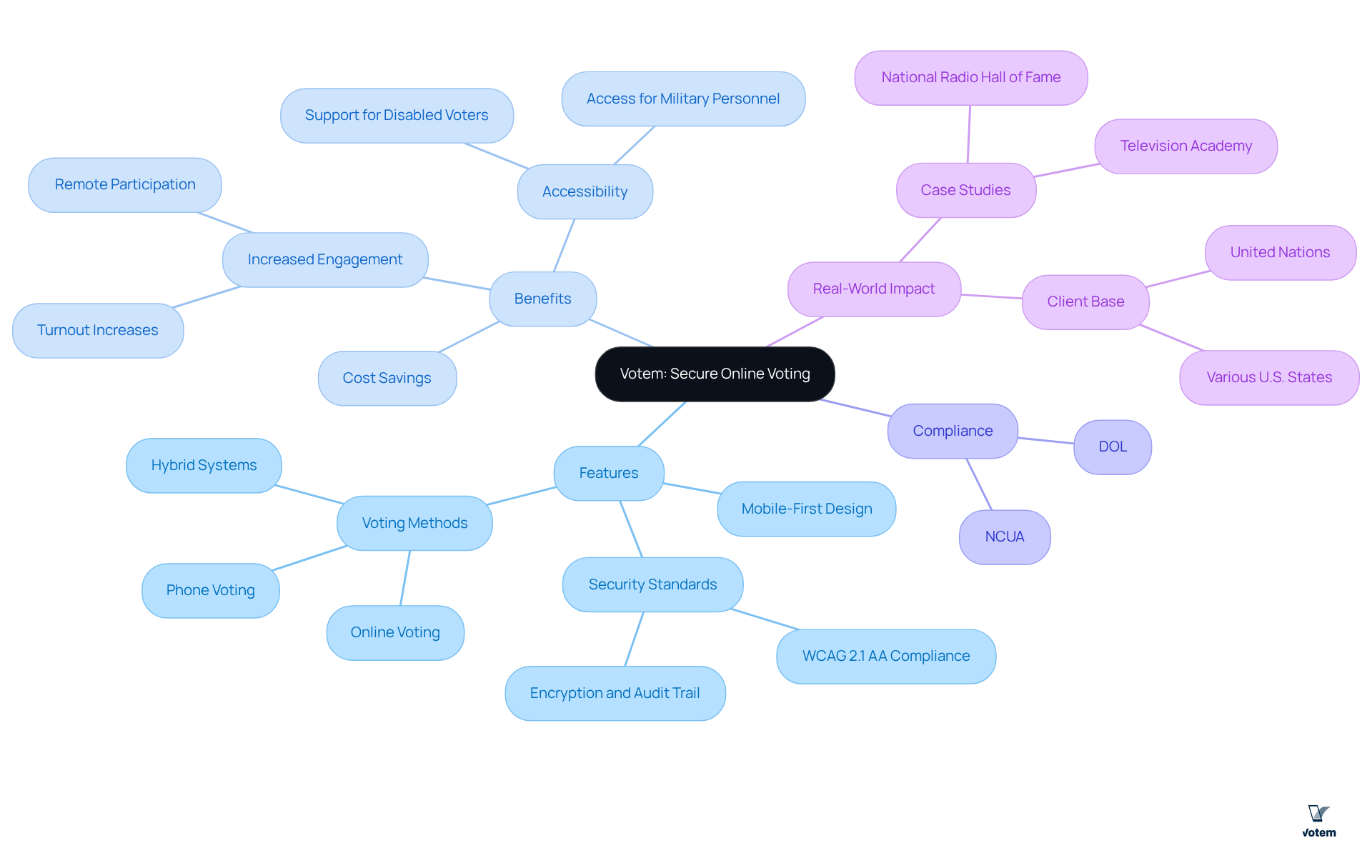
Plurality Voting: Definition and Key Characteristics
Plurality elections, commonly known as ‘first-past-the-post,’ represent a system where the individual with the highest number of votes wins, regardless of achieving an absolute majority. In a scenario with 356 participants, a candidate must obtain at least 178 votes to secure victory. This method is favored for its simplicity and speed in vote counting, making it a prevalent choice in various electoral contexts, including labor unions. However, it can result in instances where a candidate wins through plurality versus majority support, which may distort the electorate’s preferences.
Key characteristics of plurality voting include:
- Simplicity: The straightforward nature of the system facilitates quick understanding and implementation.
- Speed of Results: Votes can be counted swiftly, delivering timely outcomes critical in many electoral situations.
- Vote-Splitting: Similar candidates may divide the vote, leading to scenarios where a less favored candidate emerges victorious, a phenomenon known as the ‘spoiler effect.’ This issue can be particularly problematic in labor unions, where multiple candidates may share similar ideologies. Moreover, the presence of spoiler candidates can lead to allegations of manipulation, as these individuals might receive incentives to either run or withdraw at the last moment.
- Prevalence: Approximately 60% of elections globally utilize some form of plurality system, highlighting its widespread acceptance despite inherent drawbacks. Furthermore, Duverger’s law suggests that plurality electoral systems often evolve into a two-party framework, which disadvantages smaller parties and stifles their growth.
Public figures emphasize the importance of participation in this system, with statements reinforcing that every vote matters and that abstaining is akin to forfeiting one’s voice in the democratic process. As Debbie Stabenow aptly noted, ‘Democracy involves participation and it’s about a majority decision.’ It is crucial that we begin to actively engage in the democratic process. This underscores the vital role of participation in elections governed by plurality versus majority rules. To enhance electoral engagement, consider leveraging technology, such as Votem’s , which has the potential to triple turnout on launch day.
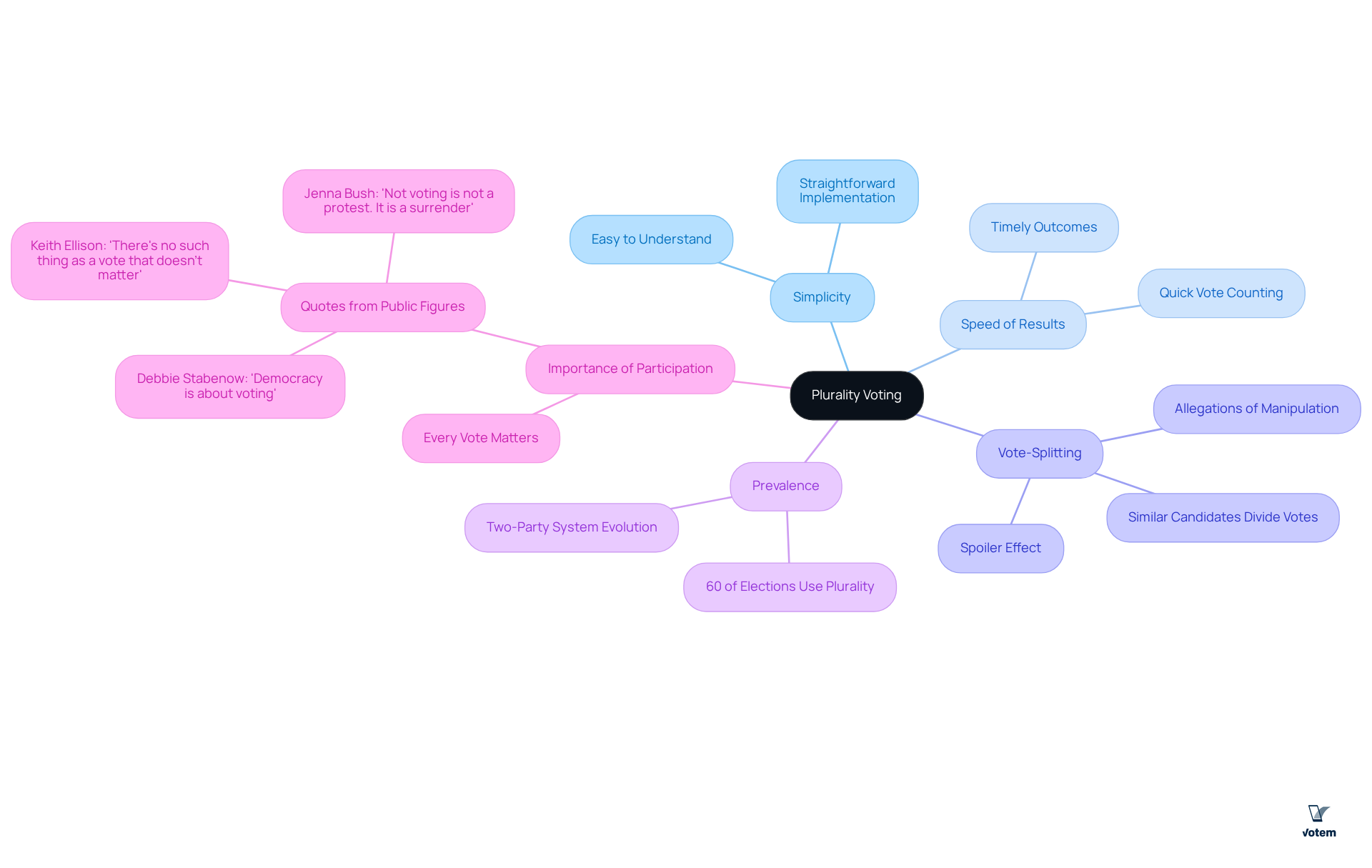
Majority Voting: Definition and Key Characteristics
In a plurality versus majority decision, an individual must secure more than 50% of the votes to be declared the winner. This requirement not only of the elected candidate but also promotes greater acceptance of the election results among voters. Conversely, in a plurality versus majority selection system, a nominee can prevail with merely 33% of the electorate’s support, underscoring the importance of collective choice in achieving broader consensus.
The predominant voting system can be implemented through various methods, including runoff elections. In scenarios where no contender achieves a plurality in the initial round, the leading candidates compete in a subsequent round, ensuring that the final selection reflects a wider agreement. This method is particularly advantageous in labor unions and credit unions, where the necessity for representative outcomes is critical. For example, in labor union elections, runoff elections can help guarantee that the ultimate candidate has the support of the majority of members, thereby bolstering trust in the electoral process.
Recent trends indicate that a significant number of elections utilize plurality versus majority systems, which reinforces its role in enhancing citizen satisfaction and confidence in the electoral process. Furthermore, Votem’s mobile-first user experience can boost voter participation by as much as threefold on launch day, further illustrating the practical benefits of adopting a predominant selection system.
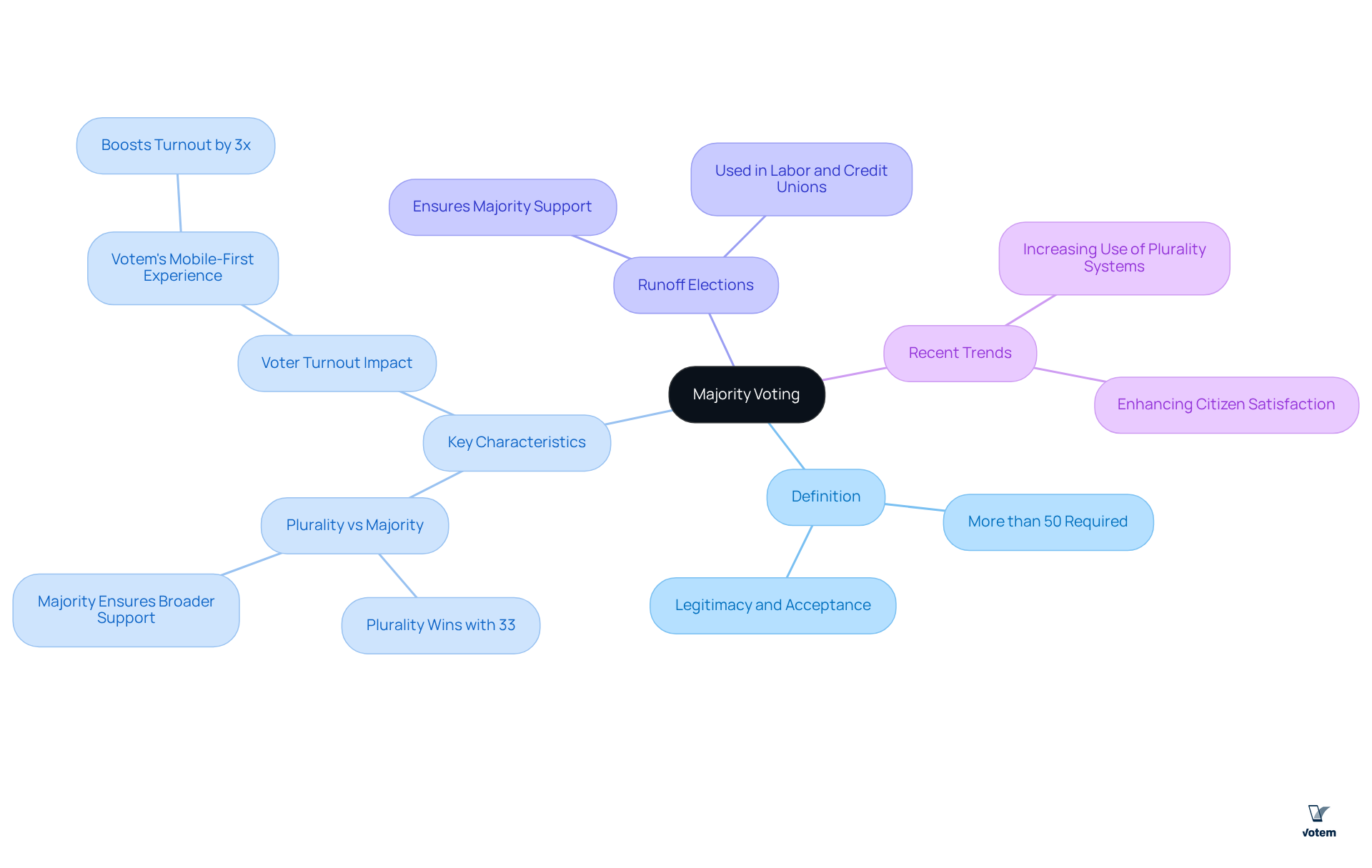
Differences Between Plurality and Majority Voting Explained
The essential distinction between plurality and winning criteria resides in the rules for success. In the context of plurality versus majority voting, the individual with the highest number of votes prevails, regardless of achieving a majority. This can lead to scenarios where a candidate is elected without broad support, as evidenced in numerous U.S. elections where a person can win with less than 50% of the votes. For instance, in a recent school election, a candidate triumphed with only 45% of the votes, leaving a considerable portion of the electorate unrepresented. This situation illustrates the potential discontent among voters when the elected individual does not reflect the preferences, highlighting the challenges of plurality versus majority.
Conversely, prevailing selection requires a contender to secure over fifty percent of the votes to succeed. This system often incorporates mechanisms like to ensure that the elected individual has the backing of a larger segment of the electorate. For example, in the French Presidential election, if no candidate achieves a dominant share in the initial round, a subsequent round of voting is conducted, typically resulting in a candidate who enjoys broader support among voters.
The implications of these electoral systems are profound. Elections that utilize plurality versus majority systems can lead to dissatisfaction among constituents, as the winning candidate may not embody the preferences of the larger group. In contrast, collective selection generally produces outcomes that more accurately reflect the electorate’s overall wishes, thereby enhancing voter trust in the electoral process. However, implementing predominant ballot systems can introduce complexities, such as the necessity for runoff elections, which may incur higher costs and delays. As organizations assess their election methods, understanding these differences is crucial for ensuring fair and effective elections.
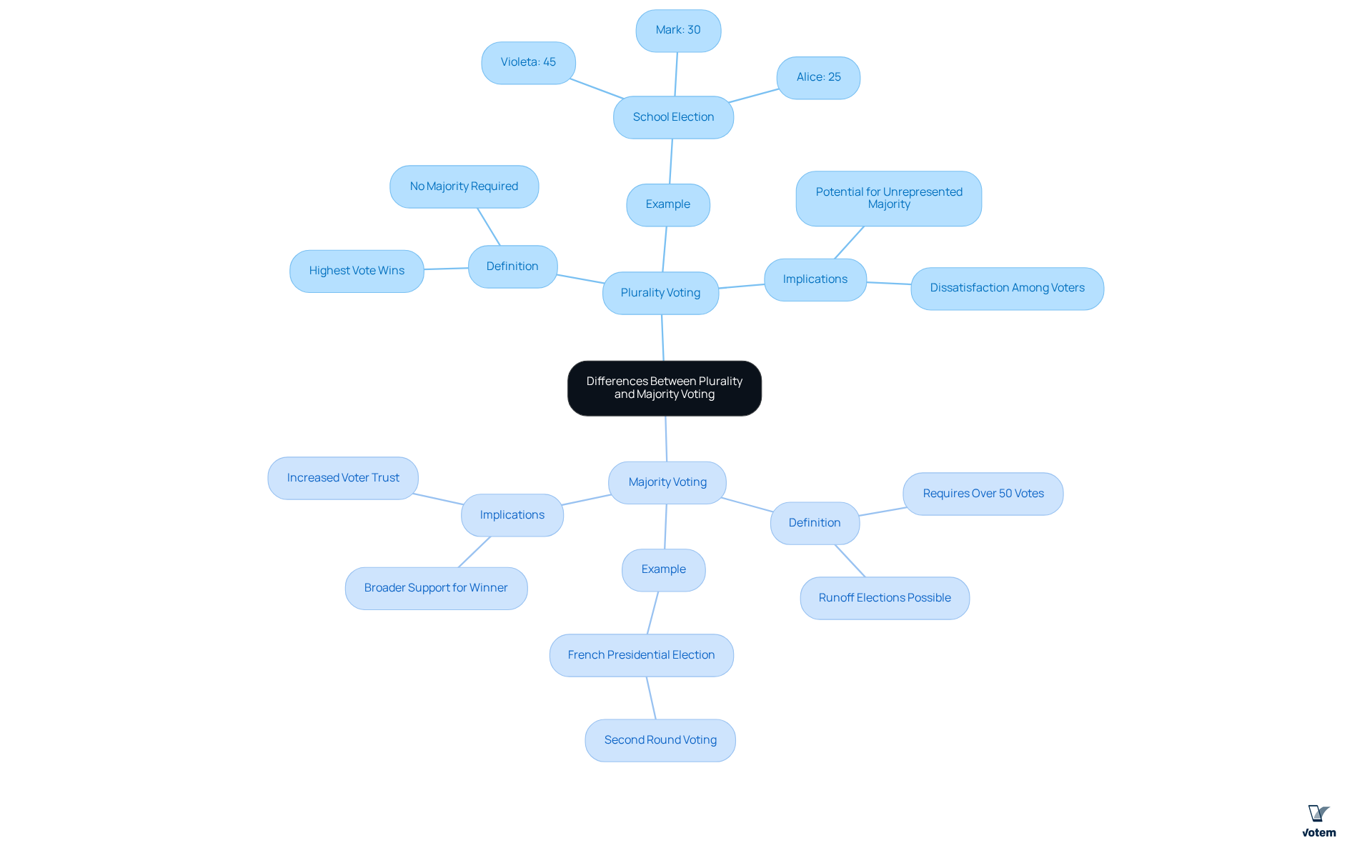
Choosing Between Plurality and Majority Voting: Considerations
When organizations evaluate the adoption of decision-making systems, several critical factors must be considered in relation to plurality versus majority. The number of contenders plays a pivotal role; in elections with numerous participants, the plurality versus majority system often suits, facilitating a swift resolution. However, this approach carries the risk of electing individuals without widespread support, potentially undermining the legitimacy of the election outcome. Conversely, majority selection is ideal when the objective is to ensure that the selected individual garners broad backing, as it requires more than 50% of the votes to prevail.
Voter engagement emerges as another essential consideration. Majority decision-making systems typically foster higher participation rates, as individuals may perceive their choices as more significant in determining a consensus candidate. For instance, Votem’s mobile-first user experience can amplify participation by up to three times on launch day, and the platform has successfully managed over 13 million votes, demonstrating its capability in handling large elections and enhancing engagement. This underscores the importance of accessibility in boosting participation.
Furthermore, organizations must weigh the implications of their chosen voting system on overall engagement. Plurality systems may inadvertently lead to diminished participation if individuals view their votes as less impactful. In contrast, plurality versus majority systems can stimulate involvement by emphasizing the necessity for a decisive winner capable of enacting change.
Ultimately, the decision regarding plurality versus majority voting should align with the organization’s goals for participant involvement, the desired level of consensus among its members, and the imperative to uphold .
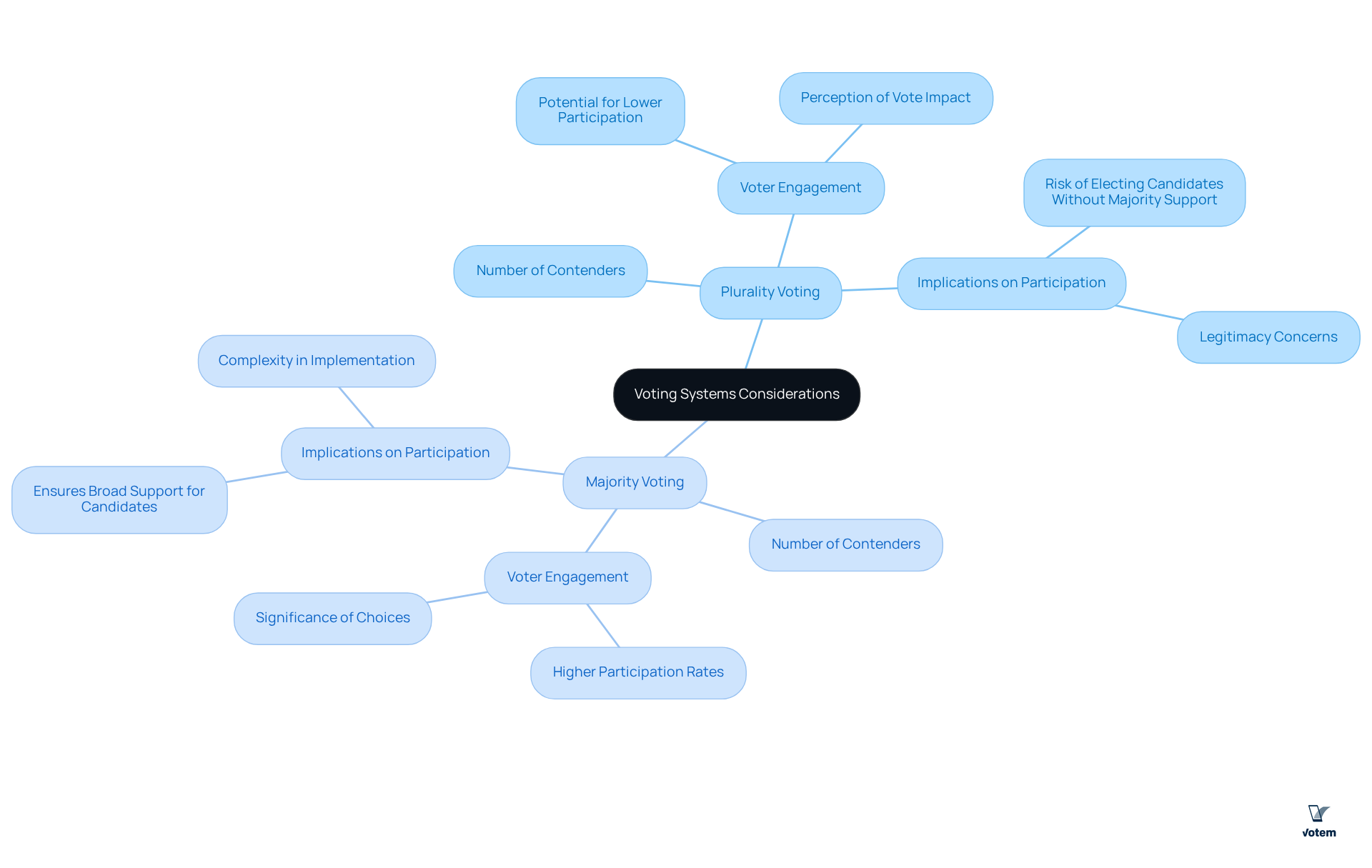
Impact of Voting Systems on Election Outcomes
The selection of an electoral system is pivotal in shaping election outcomes and influencing electorate satisfaction. Elections that emphasize plurality versus majority often result in the election of candidates who may not reflect the majority’s preferences, leading to significant public dissatisfaction. For instance, in crowded elections, a candidate can win with merely a small fraction of the total votes, leaving many voters feeling unrepresented. This sentiment is echoed by two-thirds of Americans who express a desire for a , underscoring a growing discontent with the current political landscape. Critics argue that plurality elections can foster insincere choices, where voters select candidates they perceive as more viable rather than their true preferences, as noted by political expert Tyler Biscontini. Such dynamics can exacerbate public dissatisfaction, as seen in various elections that highlight the difference between plurality versus majority, where the winning candidate did not resonate with a majority of the electorate.
Conversely, predominant selection systems tend to yield results that align more closely with the collective will of the electorate, thereby fostering greater acceptance of the outcomes. Research indicates that decision-making based on plurality versus majority can enhance public trust and participation, ensuring that elected officials have the support of at least 51% of the electorate. This is particularly crucial for organizations striving to maintain member engagement and trust in the electoral process. Additionally, ranked-choice voting (RCV) offers a mechanism that allows voters to express their genuine preferences without the fear of wasting their vote on third-party candidates, potentially increasing support for these candidates and enhancing overall engagement. By understanding these dynamics, organizations can better navigate the complexities of electoral systems and their implications for citizen engagement and satisfaction, while also considering the exploration of alternative voting methods to address these challenges.

Voter Turnout: How Voting Systems Affect Participation
Voting systems significantly influence participation rates, particularly within labor unions. Studies indicate that prevalent electoral systems often encourage higher engagement levels, as individuals perceive their ballots as more impactful in shaping outcomes. In contrast, the differences between plurality versus majority systems can foster voter apathy, especially when individuals believe their preferred candidates lack a viable chance of winning.
For instance, research reveals that turnout is seven percentage points lower in plurality systems compared to those with a larger share, underscoring the critical role of electoral structure on engagement levels. Ralph Hall observes that ‘with all else constant, turnout is seven percentage points lower in a plurality versus majority system, and five percentage points lower in a system with a simple majority compared to PR.’
Moreover, nations employing proportional representation (PR) boast an average participation rate of 77%, in stark contrast to 67% for non-PR nations. This highlights the broader context of how various can significantly affect turnout. Organizations must carefully consider these dynamics when designing their electoral processes to maximize member participation and ensure that every vote counts.
By adopting prevailing systems, unions can enhance voter confidence and encourage broader involvement in elections. Furthermore, leveraging technology, such as Votem’s mobile-first user experience, can substantially boost turnout, with reports indicating increases of up to three times on launch day.
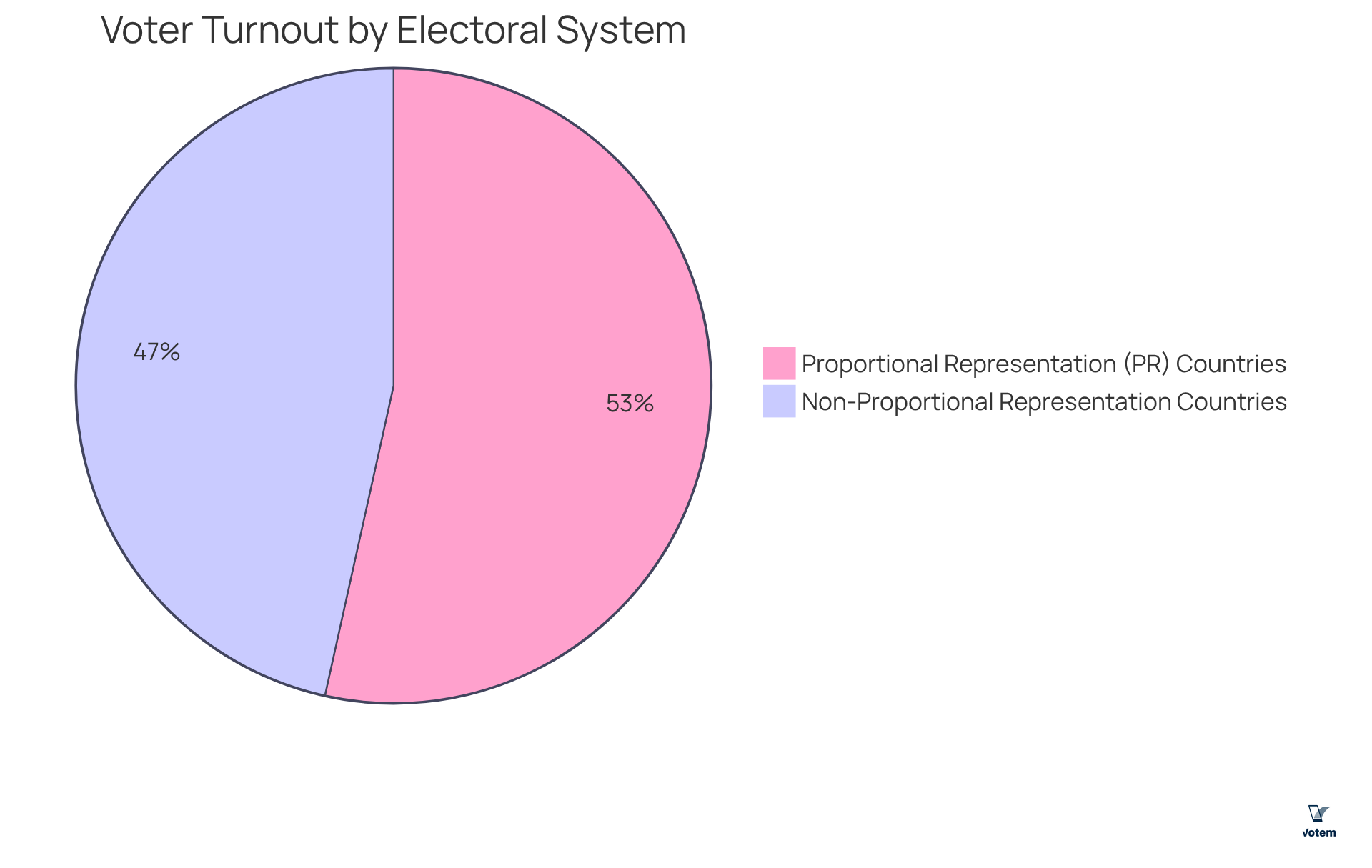
Security in Voting Systems: Ensuring Trust and Integrity
Security in ballot systems is not merely a precaution; it is essential for maintaining trust and integrity in the electoral process. Both plurality versus majority electoral systems must adopt comprehensive security measures to prevent fraud and manipulation. This includes:
- Secure ballot handling
- Encryption of votes
- Transparent auditing processes
Votem’s CastIron platform exemplifies the use of , ensuring that every ballot is encrypted both in transit and at rest. By providing an immutable audit trail, Votem enhances transparency, allowing stakeholders to verify the integrity of the results.
Furthermore, the platform’s mobile-first user experience has demonstrated the ability to boost participation by up to three times on launch day. This renders it an essential component of contemporary electoral solutions. Votem also supports weighted and multi-seat ballots, accommodating complex electoral scenarios that meet diverse organizational needs. Such measures are crucial for fostering public confidence and encouraging participation in the electoral process.
Organizations should consider adopting similar security measures to enhance their electoral integrity. The importance of robust security cannot be overstated; it is a vital step toward ensuring that every voice is heard and counted. Are you ready to take action to protect the integrity of your electoral processes?
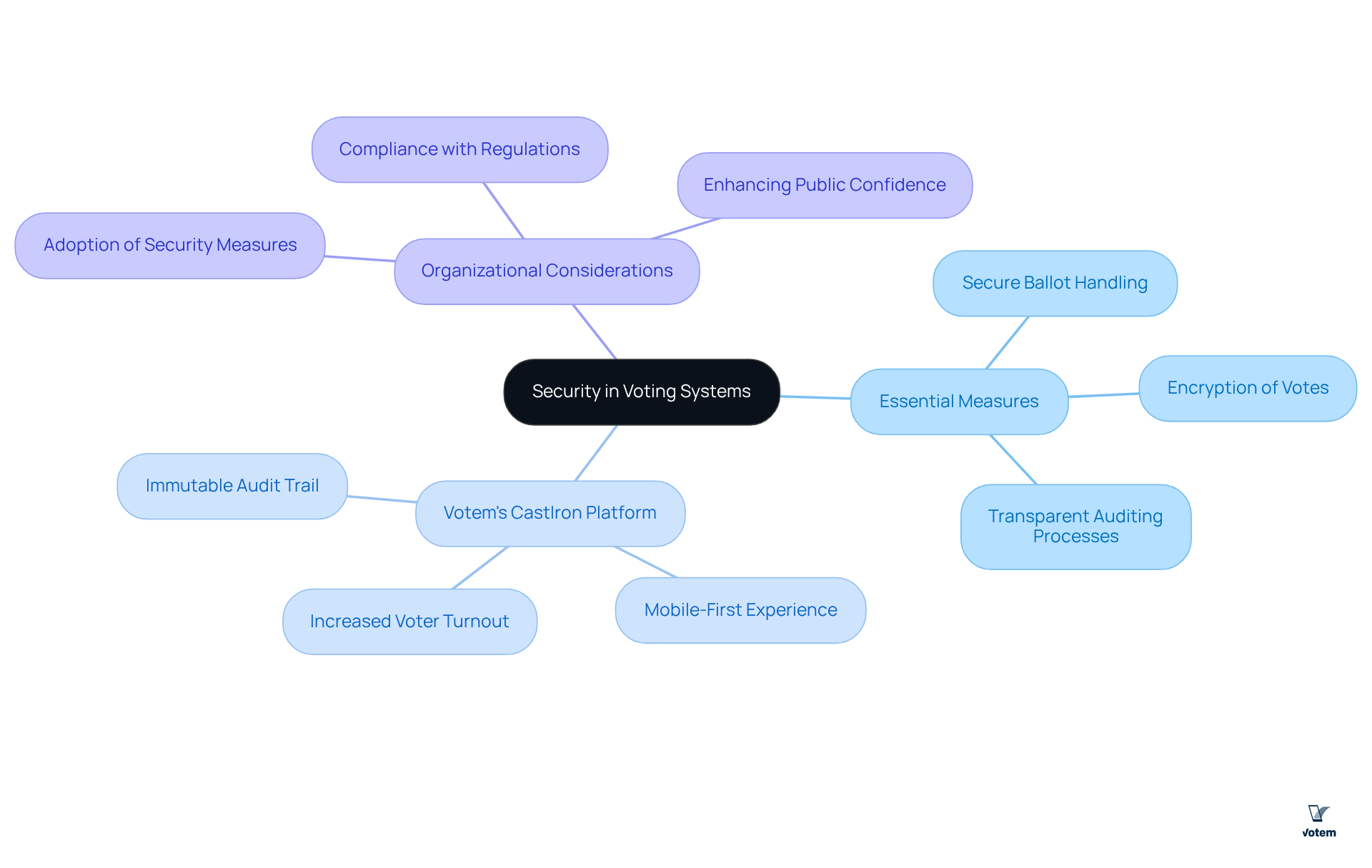
Accessibility in Voting: Making Elections Inclusive
Accessibility in elections is indispensable to guarantee that all eligible participants can engage in the process, irrespective of their physical abilities or circumstances. It is critical that both plurality versus majority election systems incorporate accessibility features, such as accessible machines and provisions for remote participation. Organizations must prioritize inclusivity in their electoral processes, ensuring that every voice is heard. This is particularly vital in labor unions, where diverse membership may encounter in accessing conventional ballot methods. By addressing these issues, union leadership can foster an environment where participation is not only encouraged but facilitated.
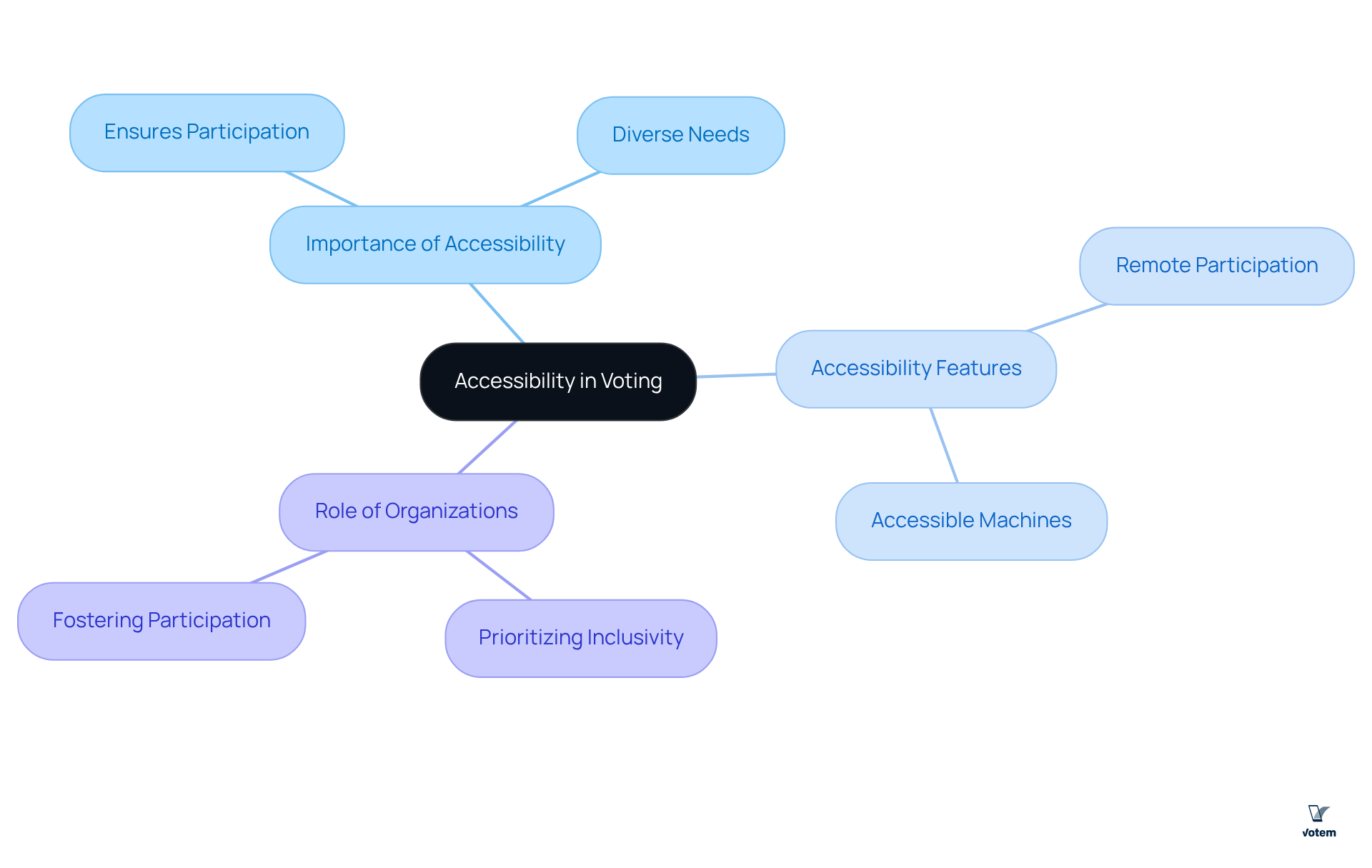
Future Trends in Voting Systems: What to Expect
The evolution of electoral systems is increasingly shaped by technological advancements and the evolving expectations of voters. Innovations such as online voting and ranked-choice voting are gaining traction, fueled by a rising demand for secure and accessible electoral processes. For instance, Votem’s CastIron platform has successfully managed over 13 million votes, showcasing its potential to enhance participation through secure online solutions. Its mobile-first user experience can significantly boost engagement, with reports indicating increases of up to three times on launch days.
Furthermore, blockchain technology emerges as a promising avenue to strengthen voter trust, offering advantages like enhanced security, transparency, and decentralization. To remain effective and representative, electoral bodies—including credit unions and labor unions—must embrace these innovative solutions. This ensures that elections continue to reflect the will of the people in a rapidly changing landscape. With a proven track record of , Votem distinguishes itself as a reliable partner in this transition.
Union leadership should stay informed about these advancements and consider adopting such technologies to enhance their electoral processes. As the landscape evolves, the integration of these innovations is not just beneficial but essential for maintaining the integrity and effectiveness of electoral systems.
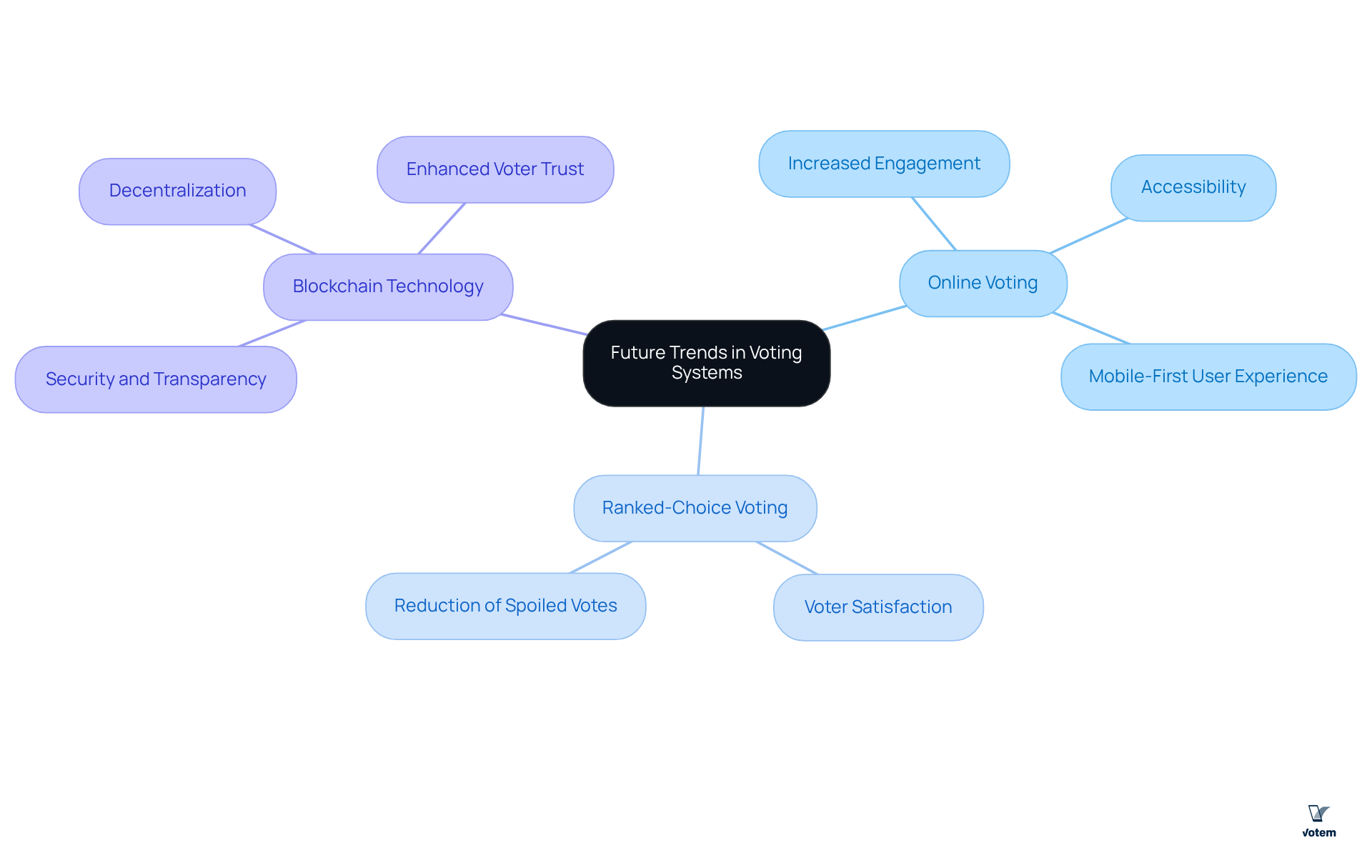
Conclusion
The differences between plurality and majority voting systems are critical in shaping electoral outcomes and influencing public engagement. Plurality voting allows candidates to win without a majority, which can lead to potential dissatisfaction among voters. In contrast, majority voting emphasizes a broader consensus, enhancing the legitimacy of elected officials. Understanding these distinctions is essential for organizations aiming to foster trust and participation in their electoral processes.
Key insights highlight how plurality systems can lead to outcomes that do not reflect the electorate’s true preferences, often resulting in voter apathy and disillusionment. Conversely, majority systems, which may include runoff elections, ensure that candidates have the support of a larger segment of the population. This approach increases voter confidence and satisfaction. Furthermore, the role of technology, such as Votem’s secure online voting platform, emerges as a valuable tool in improving voter turnout and engagement, making the electoral process more accessible and transparent.
Ultimately, the choice between plurality and majority voting systems transcends a mere technical decision; it reflects an organization’s commitment to democratic principles and member participation. As electoral landscapes evolve with technological advancements, organizations must prioritize inclusivity and security to ensure every voice is heard. Embracing these changes not only enhances the integrity of the electoral process but also empowers voters, fostering a more engaged and representative democracy.
Frequently Asked Questions
What is Votem and what does its CastIron platform offer?
Votem is a provider of secure online voting solutions, and its CastIron platform is designed to support both plurality and majority elections while ensuring compliance with essential regulations like NCUA and DOL. It aims to provide reliable electoral solutions for labor unions and credit unions.
How does Votem’s platform enhance voter engagement?
Organizations using Votem’s eVoting solutions have reported turnout increases of up to 15%. The platform’s mobile-first design also improves accessibility, allowing citizens to vote from any location, which contributes to higher engagement levels.
What accessibility standards does Votem adhere to?
Votem is committed to WCAG 2.1 AA accessibility standards, ensuring that all members, including those with disabilities, can participate in the electoral process.
What are the key characteristics of plurality voting?
Key characteristics of plurality voting include its simplicity, speed of results, and the potential for vote-splitting, where similar candidates may divide the vote, leading to less favored candidates winning. Approximately 60% of elections globally use some form of plurality system.
What are the drawbacks of plurality voting?
A major drawback of plurality voting is that a candidate can win without achieving an absolute majority, which may not accurately reflect the electorate’s preferences. This can lead to the ‘spoiler effect,’ where similar candidates split votes, potentially resulting in a less favored candidate’s victory.
How does majority voting differ from plurality voting?
In majority voting, a candidate must secure more than 50% of the votes to win, enhancing the legitimacy and acceptance of the election results. In contrast, a candidate can win a plurality election with as little as 33% of the votes.
What methods can be used in majority voting to ensure a representative outcome?
Majority voting can be implemented through methods like runoff elections, where if no candidate achieves a plurality in the first round, the leading candidates compete in a subsequent round to ensure broader consensus among voters.
How does Votem’s platform contribute to the electoral process?
Votem’s platform emphasizes security and transparency, fostering trust among the electorate and protecting the integrity of the electoral process. It can also lead to substantial cost savings for organizations using its eVoting solutions.
List of Sources
- Votem: Secure Online Voting for Plurality and Majority Elections
- Votem Corp. buys California web-based voting business Everyone Counts (https://crainscleveland.com/technology/votem-corp-buys-california-web-based-voting-business-everyone-counts)
- examples.tely.ai (https://examples.tely.ai/10-benefits-of-e-voting-for-union-leadership-engagement)
- Plurality Voting: Definition and Key Characteristics
- Plurality voting – Wikipedia (https://en.wikipedia.org/wiki/Plurality_voting)
- Plurality Voting Method | Definition, Rule & Example – Video | Study.com (https://study.com/academy/lesson/video/the-plurality-method-in-elections.html)
- These Inspiring Quotes Will Get You Excited to Vote (https://countryliving.com/life/g24446791/voting-quotes)
- Jesuit Resource – Election Day Quotes (https://xavier.edu/jesuitresource/online-resources/quote-archive1/election-dayvoting)
- 45 Inspiring Quotes About Voting and Elections (https://shutterfly.com/ideas/inspiring-quotes-about-voting-and-elections)
- Majority Voting: Definition and Key Characteristics
- monticello.org (https://monticello.org/the-art-of-citizenship/the-right-and-responsibility-to-vote/quotes)
- electionbuddy.com (https://electionbuddy.com/blog/2022/01/27/plurality-vs-majority-voting)
- 110 Patriotic Quotes About Voting and Democracy (https://everydaypower.com/quotes-about-voting-and-democracy)
- TOP 25 MAJORITY RULE QUOTES | A-Z Quotes (https://azquotes.com/quotes/topics/majority-rule.html)
- The Elementary Statistics of Majority Voting on JSTOR (https://jstor.org/stable/2981392)
- Differences Between Plurality and Majority Voting Explained
- electionbuddy.com (https://electionbuddy.com/blog/2022/01/27/plurality-vs-majority-voting)
- Ranked choice voting – SciLine (https://sciline.org/elections/ranked-choice-voting-quotes)
- Case Studies (https://starvoting.org/case_studies)
- wltx.com (https://wltx.com/article/news/politics/elections/columbia-considers-switch-majority-plurality-voting/101-30e28703-125b-4e1a-8fae-6ee0fe44f1bd)
- Plurality vs. Majority Voting | Differences & Examples – Lesson | Study.com (https://study.com/learn/lesson/plurality-voting-vs-majority-voting-summaries-differences-uses.html)
- Choosing Between Plurality and Majority Voting: Considerations
- Jesuit Resource – Election Day Quotes (https://xavier.edu/jesuitresource/online-resources/quote-archive1/election-dayvoting)
- electionbuddy.com (https://electionbuddy.com/blog/2022/01/27/what-is-the-difference-between-a-plurality-voting-system-and-a-majority-voting-system)
- electionbuddy.com (https://electionbuddy.com/blog/2022/01/27/plurality-vs-majority-voting)
- 45 Inspiring Quotes About Voting and Elections (https://shutterfly.com/ideas/inspiring-quotes-about-voting-and-elections)
- Impact of Voting Systems on Election Outcomes
- Continuing America’s Laboratory of Democracy Through State and Local Electoral Innovations (https://blogs.uofi.uis.edu/view/8598/1615284392)
- Plurality voting | Research Starters | EBSCO Research (https://ebsco.com/research-starters/political-science/plurality-voting)
- 45 Inspiring Quotes About Voting and Elections (https://shutterfly.com/ideas/inspiring-quotes-about-voting-and-elections)
- Voter Turnout: How Voting Systems Affect Participation
- Does proportional representation lead to higher turnout? (https://electoral-reform.org.uk/does-proportional-representation-lead-to-higher-turnout)
- FHWA – Center for Innovative Finance Support – Value Capture – Case Studies: Atlanta BeltLine Tax Allocation District (https://fhwa.dot.gov/ipd/value_capture/case_studies/atlanta_beltline_tax_allocation_district.aspx)
- Big voter turnout this year benefited Republicans, contradicting conventional political wisdom (https://apnews.com/article/election-2024-voter-turnout-republicans-trump-harris-7ef18c115c8e1e76210820e0146bc3a5)
- Voter turnout, 2020-2024 (https://pewresearch.org/politics/2025/06/26/voter-turnout-2020-2024)
- Security in Voting Systems: Ensuring Trust and Integrity
- csg.org (https://csg.org/2023/11/02/state-measures-to-improve-election-security-and-voter-confidence)
- Government organisation processing electoral services – KJR (https://kjr.com.au/case_studies/government-organisation-processing-electoral-services)
- Voting Site Security — (https://aceproject.org/ace-en/topics/vo/vof/vof04)
- medium.com (https://medium.com/@peacejoyaustin/top-quotes-100-democracy-the-case-for-universal-voting-e-j-dionne-jr-miles-rapoport-a5ef2fead6ca)
- Accessibility in Voting: Making Elections Inclusive
- The (https://northeastada.org/resource/about-voting-access-rights)
- americanprogress.org (https://americanprogress.org/article/enhancing-accessibility-u-s-elections)
- nist.gov (https://nist.gov/itl/voting/research-and-projects/accessibility-and-human-factors)
- Future Trends in Voting Systems: What to Expect
- mdpi.com (https://mdpi.com/2079-9292/13/1/17)
- news.uchicago.edu (https://news.uchicago.edu/story/voting-mobile-devices-increases-election-turnout)
- aaas.org (https://aaas.org/epi-center/future-voting-technology)
- americanprogress.org (https://americanprogress.org/article/pass-the-freedom-to-vote-act-how-elections-would-look-different-this-year-and-in-the-future)

